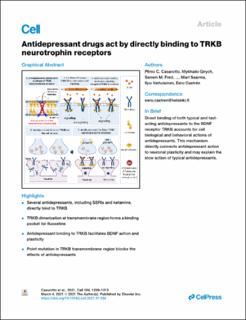| dc.contributor.author | Casarotto, Plinio C. | |
| dc.contributor.author | Girych, Mykhailo | |
| dc.contributor.author | Fred, Senem M. | |
| dc.contributor.author | Kovaleva, Vera | |
| dc.contributor.author | Moliner, Rafael | |
| dc.contributor.author | Enkavi, Giray | |
| dc.contributor.author | Biojone, Caroline | |
| dc.contributor.author | Cannarozzo, Cecilia | |
| dc.contributor.author | Sahu, Madhusmita Pryiadrashini | |
| dc.contributor.author | Kaurinkoski, Katja | |
| dc.contributor.author | Brunello, Cecilia A. | |
| dc.contributor.author | Steinzeig, Anna | |
| dc.contributor.author | Winkel, Frederike | |
| dc.contributor.author | Patil, Sudarshan | |
| dc.contributor.author | Vestring, Stefan | |
| dc.contributor.author | Serchov, Tsvetan | |
| dc.contributor.author | Diniz, Cassiano R.A.F. | |
| dc.contributor.author | Laukkanen, Liina | |
| dc.contributor.author | Cardon, Iseline | |
| dc.contributor.author | Antila, Hanna | |
| dc.contributor.author | Rog, Tomasz | |
| dc.contributor.author | Piepponen, Timo Petteri | |
| dc.contributor.author | Bramham, Clive Raymond Evjen | |
| dc.contributor.author | Normann, Claus | |
| dc.contributor.author | Lauri, Sari E. | |
| dc.contributor.author | Saarma, Mart | |
| dc.contributor.author | Vattulainen, Ilpo | |
| dc.contributor.author | Castrén, Eero | |
| dc.date.accessioned | 2022-04-06T12:02:39Z | |
| dc.date.available | 2022-04-06T12:02:39Z | |
| dc.date.created | 2022-01-18T15:05:32Z | |
| dc.date.issued | 2021 | |
| dc.identifier.issn | 0092-8674 | |
| dc.identifier.uri | https://hdl.handle.net/11250/2990222 | |
| dc.description.abstract | It is unclear how binding of antidepressant drugs to their targets gives rise to the clinical antidepressant effect. We discovered that the transmembrane domain of tyrosine kinase receptor 2 (TRKB), the brain-derived neurotrophic factor (BDNF) receptor that promotes neuronal plasticity and antidepressant responses, has a cholesterol-sensing function that mediates synaptic effects of cholesterol. We then found that both typical and fast-acting antidepressants directly bind to TRKB, thereby facilitating synaptic localization of TRKB and its activation by BDNF. Extensive computational approaches including atomistic molecular dynamics simulations revealed a binding site at the transmembrane region of TRKB dimers. Mutation of the TRKB antidepressant-binding motif impaired cellular, behavioral, and plasticity-promoting responses to antidepressants in vitro and in vivo. We suggest that binding to TRKB and allosteric facilitation of BDNF signaling is the common mechanism for antidepressant action, which may explain why typical antidepressants act slowly and how molecular effects of antidepressants are translated into clinical mood recovery. | en_US |
| dc.language.iso | eng | en_US |
| dc.publisher | Elsevier | en_US |
| dc.rights | Navngivelse 4.0 Internasjonal | * |
| dc.rights.uri | http://creativecommons.org/licenses/by/4.0/deed.no | * |
| dc.title | Antidepressant drugs act by directly binding to TRKB neurotrophin receptors | en_US |
| dc.type | Journal article | en_US |
| dc.type | Peer reviewed | en_US |
| dc.description.version | publishedVersion | en_US |
| dc.rights.holder | Copyright 2021 The Author(s) | en_US |
| cristin.ispublished | true | |
| cristin.fulltext | original | |
| cristin.qualitycode | 2 | |
| dc.identifier.doi | 10.1016/j.cell.2021.01.034 | |
| dc.identifier.cristin | 1983806 | |
| dc.source.journal | Cell | en_US |
| dc.source.pagenumber | 1299-1313 | en_US |
| dc.identifier.citation | Cell. 2021, 184 (5), 1299-1313. | en_US |
| dc.source.volume | 184 | en_US |
| dc.source.issue | 5 | en_US |

